Traditional Southern Fried Chicken is a true classic with its delightfully golden and perfectly crispy crust and tender, juicy meat. Marinated in buttermilk and cooked to perfection, bite after bite, it is nothing less than a flavor explosion in your mouth.
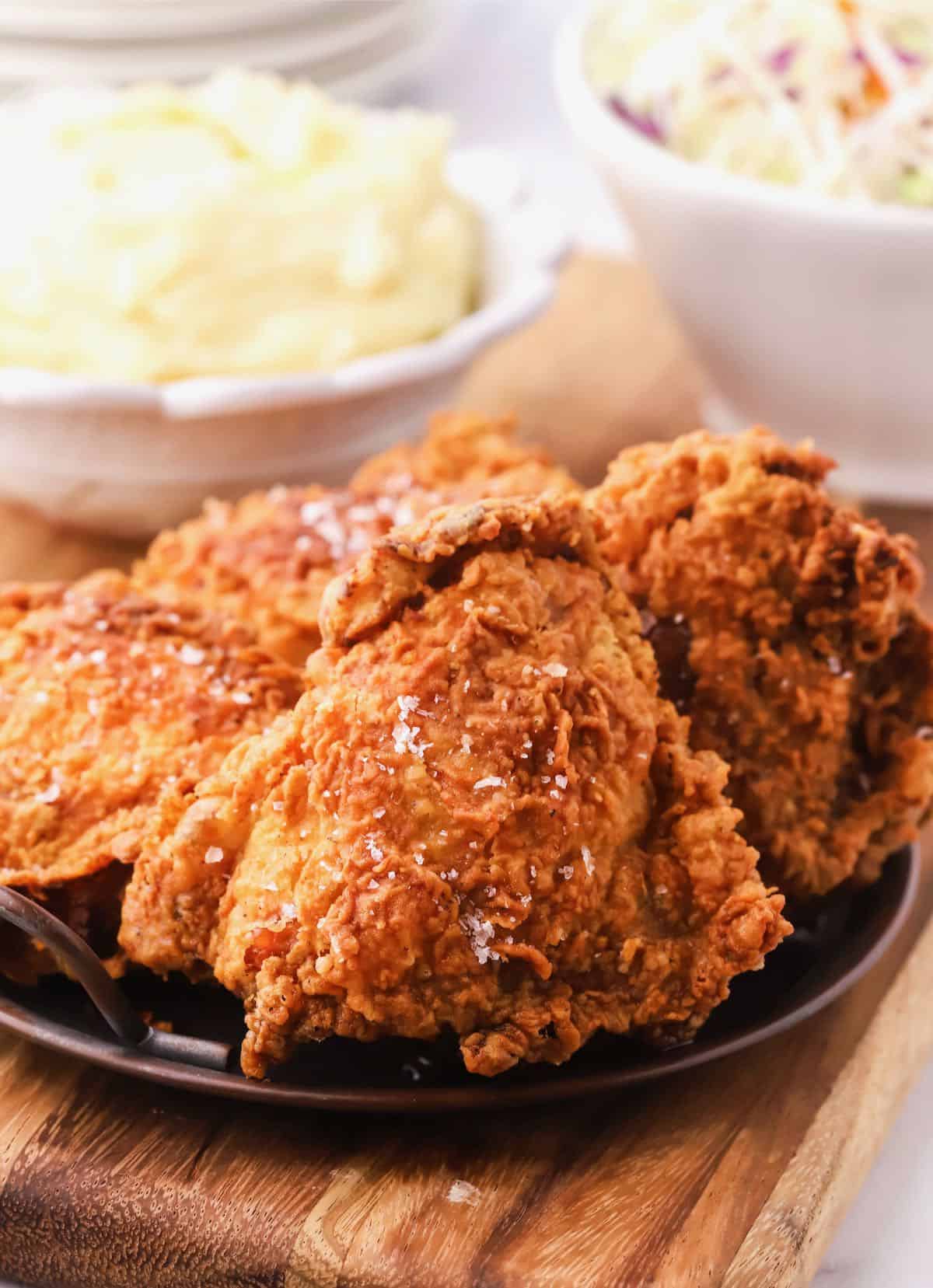
If you had to choose one dish that personifies the South, it would have to be fried chicken! Covered with a thick, crunchy, and flavorful crust, this iconic and versatile dish is as perfect for a casual lunch or dinner as it is for tailgating or a summer picnic.
Like many other Southern dishes, there are probably as many recipes for fried chicken as there are cooks. There is a wide range of different techniques, including brining, marinating in buttermilk, and adding different seasonings to the flour or buttermilk.
This easy fried chicken recipe features a buttermilk marinade, which tenderizes and adds flavor and moisture to the meat and includes just the right balance of seasoning.
If you have ever tried to fry anything, you probably already know too well that many things can go wrong. But by following my foolproof step-by-step instructions, you can make authentic fried chicken that rivals the best Southern chefs!
Here’s what you need:
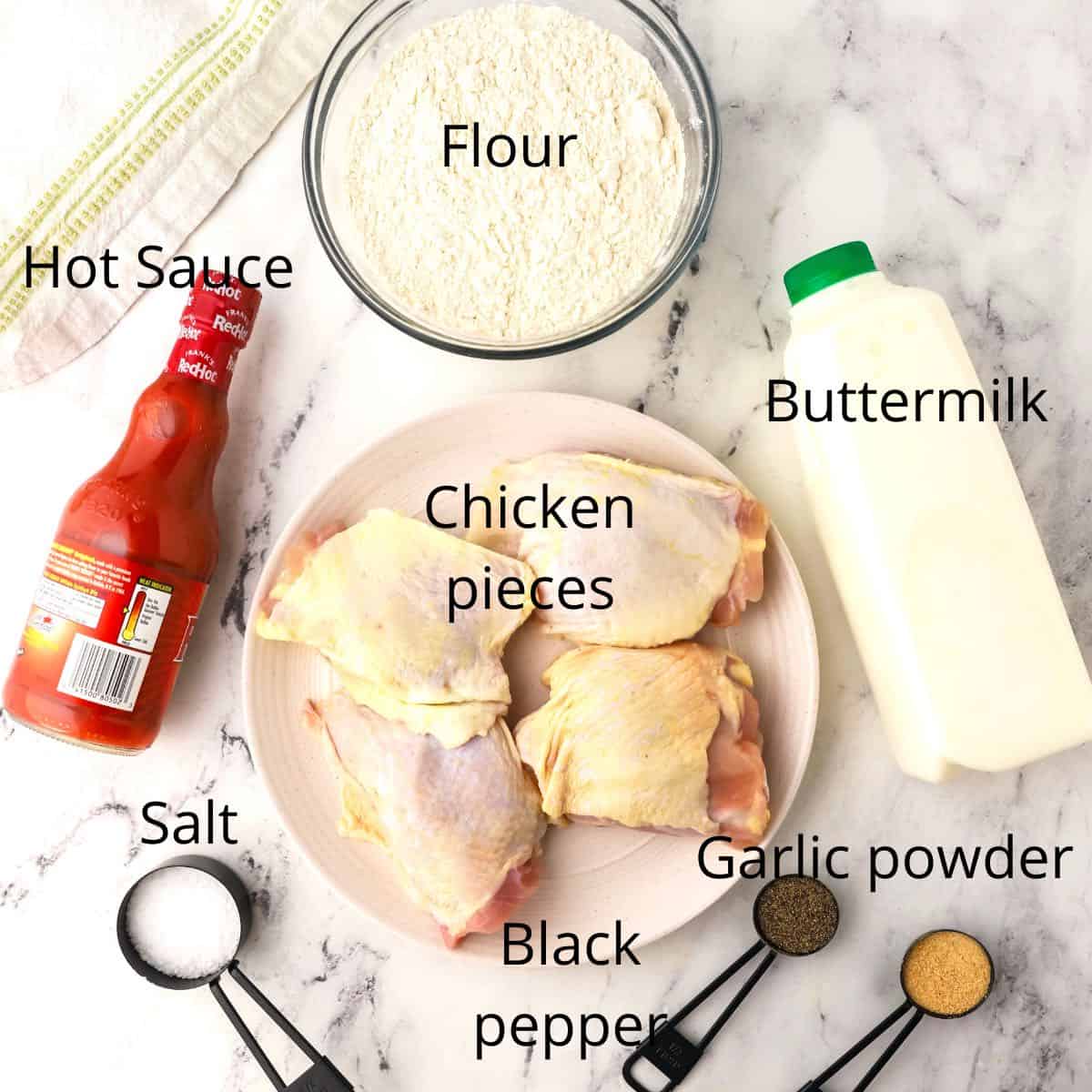
- Bone-in, skin-on chicken pieces – are the main ingredient in this show. You can use boneless, skinless chicken, but the crust will not be as thick or crunchy.
- Buttermilk – rich, thick, and tangy, it forms the base of the marinade and not only gives the chicken great flavor but also makes it tender and juicy!
- Hot sauce and garlic powder – combine with the buttermilk to make an outstanding flavor-packed marinade.
- Flour – all-purpose flour forms the base of the coating that blankets the chicken and makes a delicious crust.
- Kosher salt and ground black pepper – combine with the flour and provide the perfect balance of seasoning to enhance all of the flavors.
- Peanut oil – I always use peanut oil when frying because of its high smoke point. You can also use soybean oil, safflower oil, rice bran oil, or vegetable oil.
- Equipment needed – candy/ deep-fry thermometer, an instant-read meat thermometer, and a cast-iron skillet or dutch oven.
How to make it:
- Combine the buttermilk, garlic, and hot sauce in a large bowl.
- Add the chicken, cover and refrigerate for a minimum of four hours or up to 24 hours. The longer, the better.
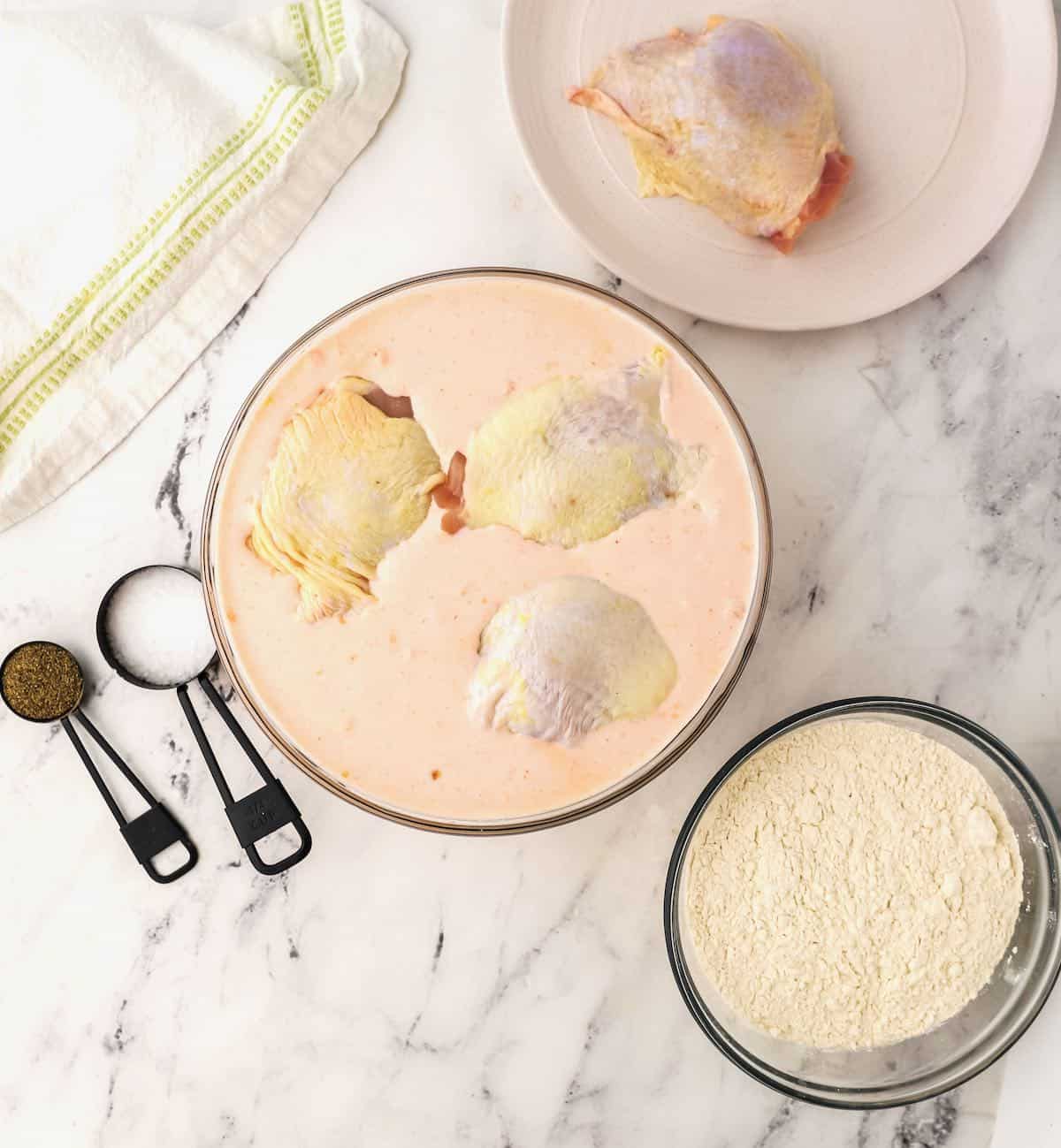
- About an hour before you are ready to cook, remove the poultry from the refrigerator and let it come to room temperature. Doing this will allow it to cook more evenly.
- Add the flour, salt, and pepper to a large gallon-size plastic storage bag.
- Remove the chicken from the buttermilk and allow any excess to drip off. Add one piece at a time to the bag with the flour mixture and shake so that everything is evenly coated.
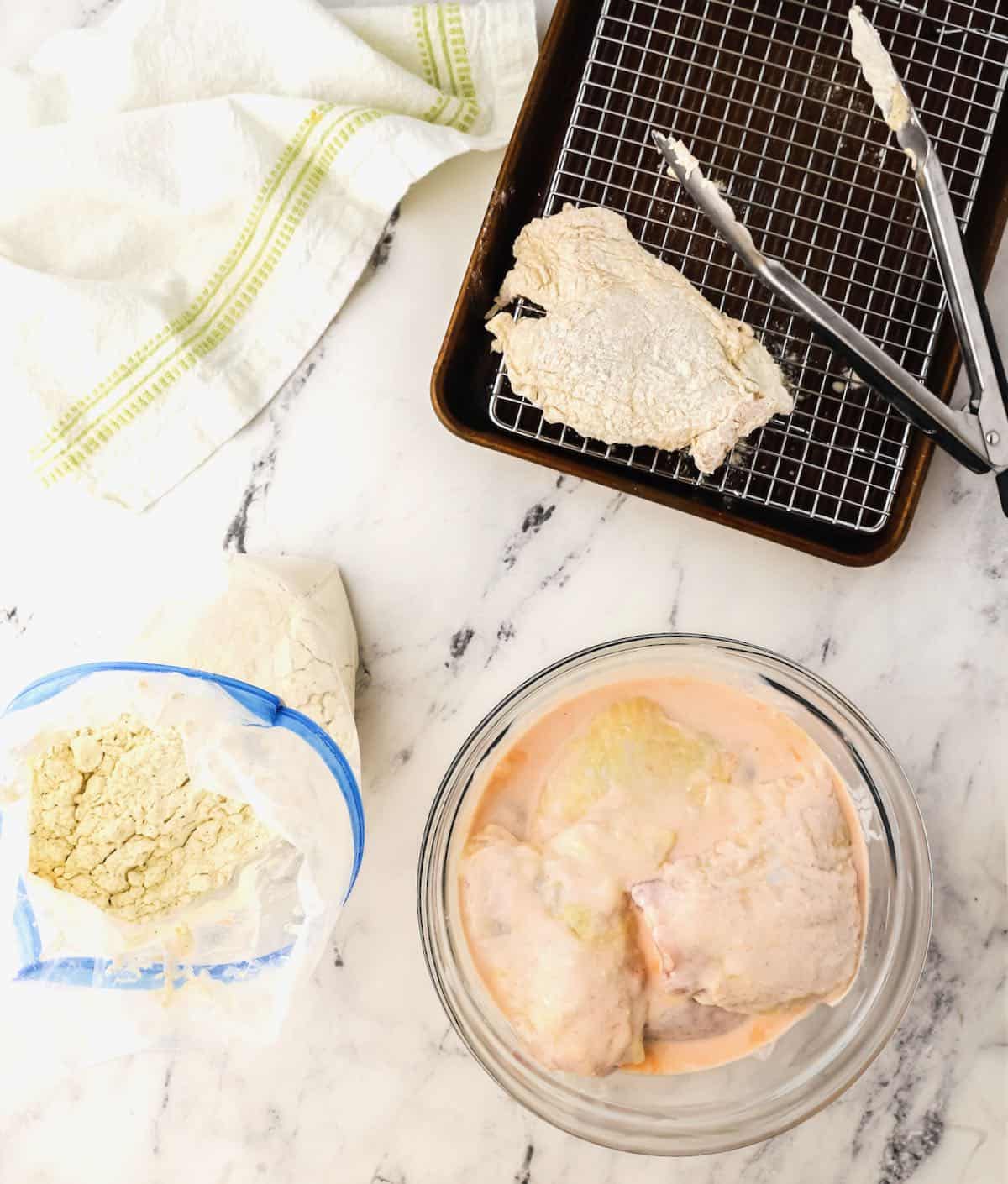
- Shake off any excess flour and place it on a wire rack. Once all of the poultry has been coated with flour, allow it to sit on the rack for about 30 minutes to firm up the coating.

- When ready to fry, pour the oil in a deep cast-iron Dutch oven or cast-iron skillet. You may need a little less or more oil, depending on the size of your pan. The oil should be approximately one to one and one-half inches deep.
- Place the pan over medium-high heat and heat the oil to 350 degrees F.
- Carefully add a few chicken pieces, and be sure not to crowd them. I usually cook three pieces at a time.
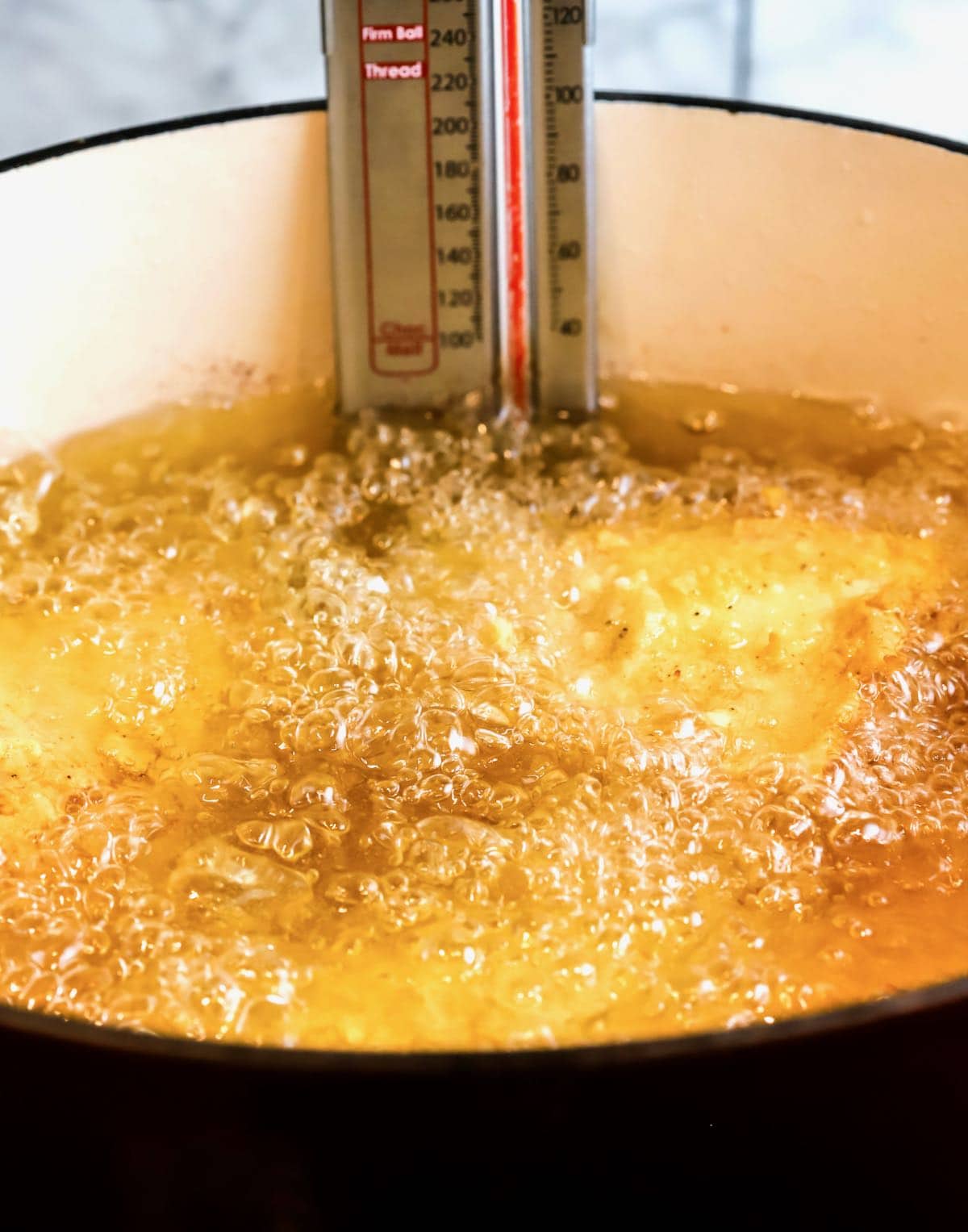
- The oil temperature will come down once the meat has been added. It is crucial to monitor it continually, and I have found 315 degrees F. is the perfect oil temperature for frying.
- You will probably need to adjust the heat under the pan to keep it at 315 degrees. If the oil gets too hot, the crust will burn before the meat is done, and if it’s not hot enough, the crust will be greasy.
- Fry for a total of 10-20 minutes. Dark meat and larger pieces will take more time to cook. White meat and smaller pieces will take less time to cook.
- Both white and dark meat is done when the internal temperature reaches 165 degrees F. Use an instant-read meat thermometer inserted in the meat, not touching the bone to determine the temperature.
- When the chicken is done, place it on a wire rack over some paper towels to allow it to cool slightly before serving. Do not put it directly on the paper towels, or your crust will get soggy.
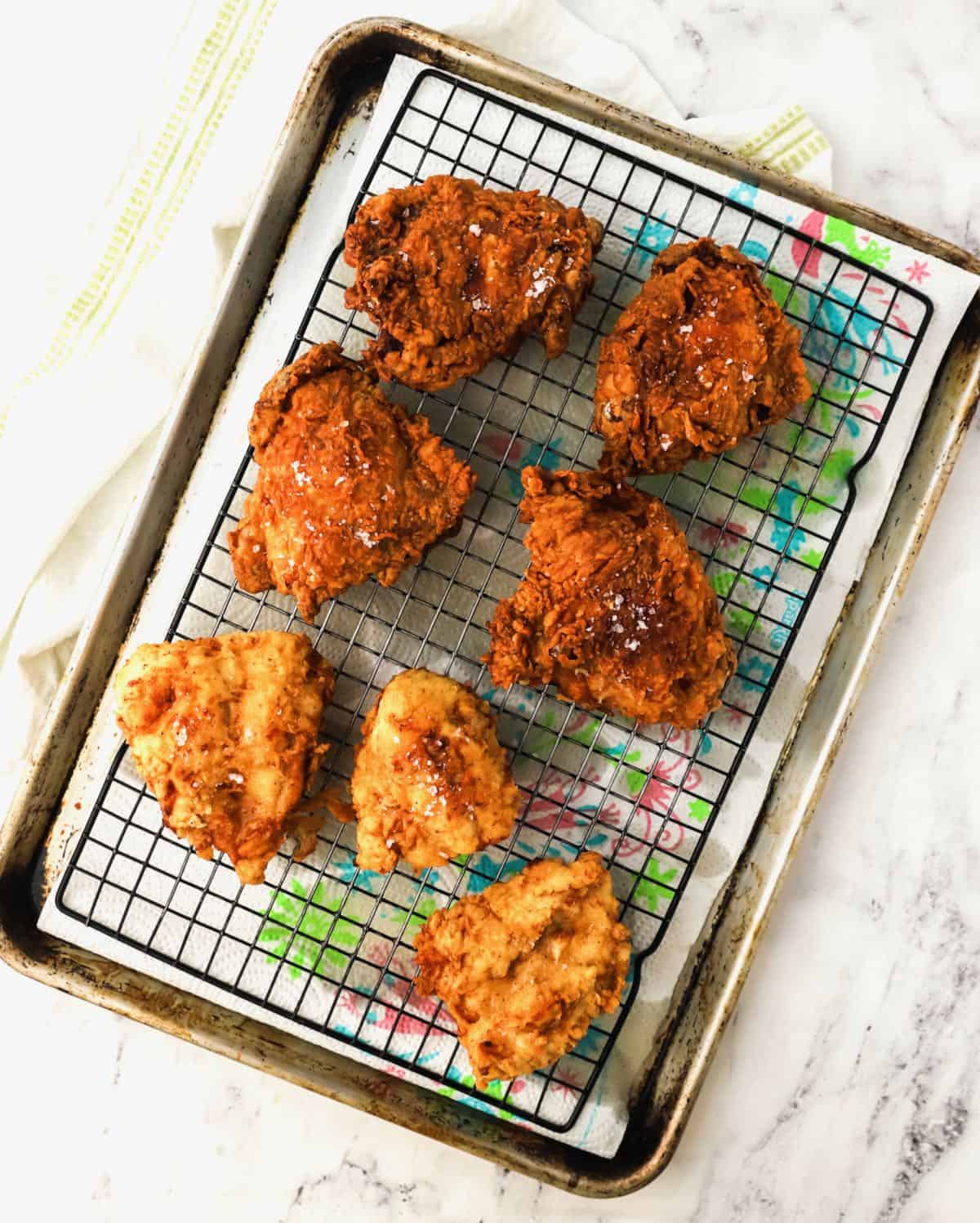
- Repeat the steps above to fry the rest of the chicken.
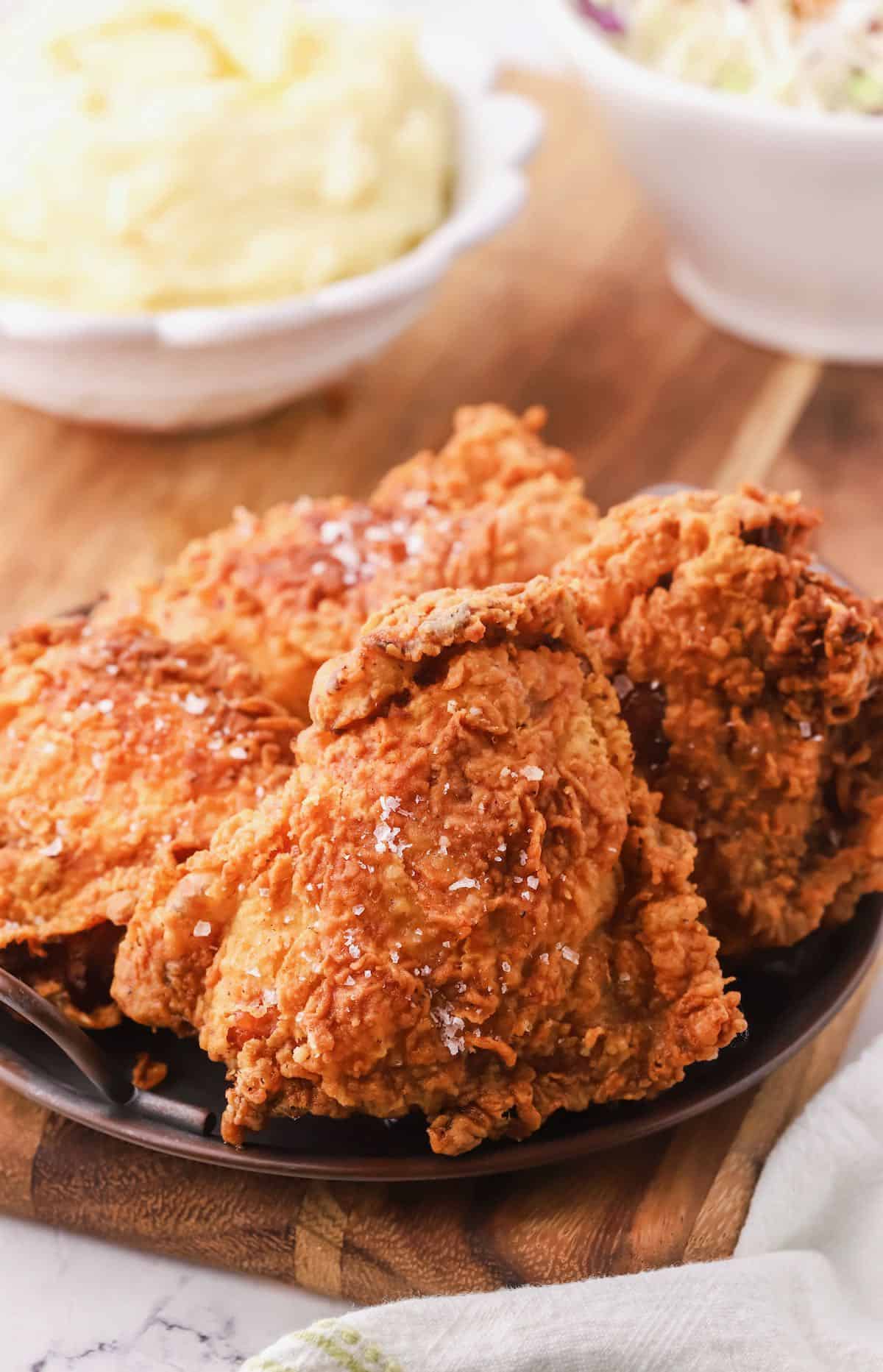
Frequently asked questions:
Double-dipping is coating the chicken in the buttermilk marinade twice and coating it twice in the seasoned flour before frying. I can’t believe I’m saying this, but to me, double-dipping produces too much crust, which I think takes away from the dish. Of course, if you prefer to double-dip, by all means, go for it!
There are several reasons why your crust might not be crispy, including not having the oil at the correct temperature or allowing the chicken to drain on paper towels instead of a wire rack. Check out all of my tips below to ensure your crust is perfect every time.
The best way to reheat fried chicken is to use your oven. I don’t recommend a microwave. To reheat, place the pieces on a wire rack set in a rimmed baking sheet in a 400-degree oven. Heat for 10-15 minutes. Start checking at 10 minutes.
Two things are essential: first, the buttermilk marinade, and then the proper oil temperature when cooking. You must use a candy or deep-frying thermometer to monitor your oil temperature.
Fried chicken is just as good served cold, straight out of the fridge, as it is warm, and it is always the most popular dish at potlucks. Pair it with my Southern Potato Salad and Smoked Baked Beans, and you will have everyone asking for more.
Other great sides include Mashed Potatoes and White Acre Peas. Of course, it would also be delicious with Mac and Cheese, Twice-Baked Potatoes, Homemade Creamed Corn, Corn Salad, Broccoli Salad, or a Cucumber and Tomato Salad.
And, if you want to add some spicy heat, try drizzling on some hot honey for a change of pace.
Sharon’s Expert Tips:
- Your meat will cook more uniformly if you remove it from the refrigerator about an hour before you fry it.
- I prefer to fry thighs. One, because dark meat is much more forgiving and more flavorful, and two, because the same size pieces will cook in approximately the same amount of time. If you prefer white meat and the breasts are large, cut them up into two or three pieces. For assorted pieces, keep in mind they will each take a different amount of time to cook.
- If the crust browns too quickly before the meat is done, remove it from the oil. Preheat your oven to 325 degrees and place the underdone chicken on a wire rack over a baking sheet. Cook for five to ten minutes or until the meat reaches the correct internal temperature.
- While a regular cast-iron skillet is perfect for frying, I prefer to use a deep cast-iron Dutch oven because it helps to minimize the chances of grease splatter.
- If you are feeding a crowd, there is more than enough buttermilk marinade, flour mixture, and oil to cook up a few more pieces.
- You can make this recipe on the stove, or you can use a deep-fryer. I have not tested it in an air-fryer.
Related recipes:
If you like this recipe, you might also like these popular Southern-style recipes: Smoked Baked Beans, Sweet and Sour Green Beans made with Canned Green Beans, Cheese Grits Casserole, Fried Cabbage with Bacon, Southern Fried Fish, Smoked Chicken Thighs, Pecan Crusted Chicken, and Crispy Fried Oysters.
If you need more menu ideas or recipes, here is a link to all of my Southern-style recipes.
⭐ ⭐ ⭐⭐⭐ If you make this dish, please leave a comment and give this recipe a star rating. I would love to know how you liked it!
Thank you so much for visiting Grits and Pinecones; I hope you come back soon!
📋 Recipe:
Want to Save This Recipe?
Enter your email & I’ll send it to your inbox. Plus, get great new recipes from me every week!
By submitting this form, you consent to receive emails from Grits and Pinecones.
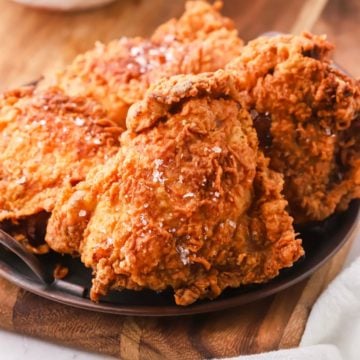
Southern Fried Chicken Recipe
Ingredients
- 6 chicken thighs (skin on with bones, or six assorted chicken pieces)
Buttermilk marinade
- 1 quart buttermilk
- ⅓ cup hot sauce (I use Frank's Red Hot Cayenne Pepper Sauce; you can also use Tabasco Sauce)
- 1 tablespoon garlic powder
Seasoned flour coating
- 4 cups all-purpose flour
- 4 tablespoons kosher salt
- 1 tablespoon ground black pepper
- 1 quart peanut oil (the amount may vary depending on the size of the pan you are using)
Instructions
- Combine the buttermilk, garlic, and hot sauce in a large bowl.
- Add the chicken, cover and refrigerate for a minimum of four hours or up to 24 hours. The longer, the better.
- About an hour before you are ready to fry, remove the bowl from the refrigerator and let everything come to room temperature. Doing this will allow the meat to cook more evenly.
- Add the flour, salt, and pepper to a large gallon-size plastic storage bag.
- Remove one piece at a time from the buttermilk and allow any excess to drip off. Place the piece in the bag with the flour mixture and shake so that the chicken is evenly coated. Shake off any excess flour and place it on a wire rack.
- Once all of the pieces have been coated with flour, allow them to sit on the rack for about 30 minutes to firm up the coating.
- When you are ready to fry, pour the oil in a deep cast-iron Dutch oven or cast-iron skillet. You may need a little less or more oil, depending on the size of your pan. The oil should be approximately one to one and one-half inches deep.
- Place the pan over medium-high heat and heat the oil to 350 degrees F. Use a candy or deep-frying thermometer to monitor the temperature of the oil.
- Carefully add a few pieces and be sure not to crowd them. I usually cook three pieces at a time.
- The oil temperature will come down once the chicken has been added. It is crucial to continually monitor it and I have found; 315 degrees F. is the perfect oil temperature for frying chicken. You will probably need to adjust the heat under the pan to keep it at 315 degrees. If the oil gets too hot, the crust will burn before the meat is done, and if it is too low, the chicken will be greasy.
- Fry for a total of 10-20 minutes. Dark meat and larger pieces will take more time to cook. White meat and smaller pieces will take less time to cook. Try to cook the same size pieces at the same time.
- Both white and dark meat is done when the internal temperature reaches 165 degrees F. Use an instant-read meat thermometer inserted in the meat not touching the bone to determine the temperature.
- When the chicken is done, place it on a wire rack over some paper towels to allow it to cool slightly before serving. Do not put it directly on the paper towels or your crust will get soggy.
- Repeat the steps above to fry the rest of the chicken.
Notes
- The temperature of the oil can make the difference between a golden-brown and underdone or a burned crust. You must use a candy or deep-frying thermometer to monitor your oil temperature.
- Your meat will cook more uniformly if you remove it from the refrigerator about an hour before you fry it.
- I prefer to fry thighs. One because dark meat is much more forgiving and more flavorful, and two, because the same size pieces will cook in approximately the same amount of time. If you prefer white meat and the breasts are large, cut them up into two or three pieces. For assorted pieces, keep in mind they will each take a different amount of time to cook.
- If the crust browns too quickly, before the meat is done, remove it from the oil. Preheat your oven to 325 degrees and place the underdone chicken on a wire rack over a baking sheet. Cook for 5-10 minutes or until it reaches the correct internal temperature.
- A regular cast-iron skillet is perfect for frying. But I like to use a deep cast-iron Dutch oven because it helps to minimize the chances of grease splatter.
- To reheat, place the pieces on a lightly greased rimmed baking sheet in a 400-degree oven. Cook for 10-15 minutes. Start checking it at 10 minutes.
- If you are feeding a crowd, there is more than enough buttermilk marinade, flour mixture, and oil to cook up a few more pieces.
- You can make this recipe on the stove, or you can use a deep-fryer. I have not tested it in an air-fryer.



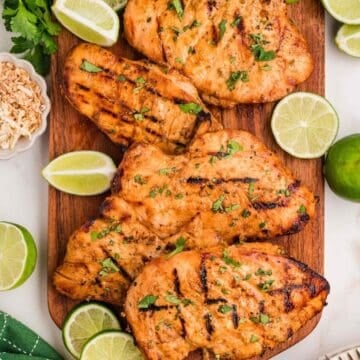
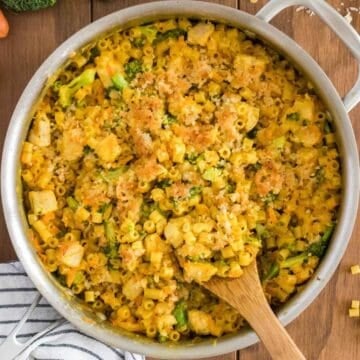
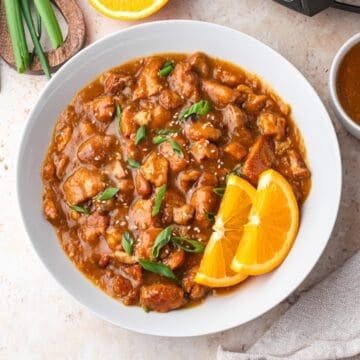

Ashley
Those are REALLY good tips for the ultimate delicious tender fried chicken. I am definately going to be begging my husband “Fry Daddy” who hates frying .. LOL to make this!!!
Ashley
That looks DELICIOUS! I truly enjoy reading your post in regards to your amazing dishes! They make me SMILE EVERYTIME!! 🙂 Winner Winner to that Chicken Dinner!!
Kelly | Foodtasia
Sharon, this fried chicken is perfection! Love that crispy crust and I agree with you on single dipping vs. double dipping. I see that you use peanut oil. Is there a reason why you use peanut oil and do you have any experience with the effects of other types of oil on crispiness?
Sharon Rigsby
Hi Kelly,
I’m so glad you enjoyed the fried chicken. I use peanut oil because it has a higher smoke point than other oils and I think it has a lighter flavor too. I’m experimenting with a rice bran oil which is supposed to be healthier, but the jury is still out. Thanks so much for taking the time to leave a comment.
All the best,
Sharon
Linger
I, too, grew up eating fried chicken … at least once a week around my house. It is such a comfort food! I love all your tips for this recipe, especially the one where you let the battered chicken rest before frying. I have never heard that before. So interesting. Your photos make this chicken look so tempting. I will have to try fried chicken again soon and will definitely use your tips. Thanks so much Sharon for sharing!
Sally
YUM! Gotta make this! I grew up on fried chicken too (I’m from NC), and this looks so delish! I’ve not actually successfully made it for myself though (yet), but your tips and tricks have me inspired to try it real soon! Thanks for the inspiration!
Gritsandpinecones
Thanks so much for leaving a comment Sally I hope you will try it soon and please do let me know how you like it!
All my best,
Sharon
Carolyn Haley
I never fry chicken anymore but after reading your blog post I am now craving some.
Vicki
This sounds very good, but is the recipe correct that you only use six chicken thighs? A quart of buttermilk and a quart of floured sounds like way too much for that small amount of chicken. The recipe says it serves six…..that would barely feed the two guys in my family!
Gritsandpinecones
Hi Vicki,
Yes, I only used 6 thighs in this recipe, because it’s just my husband and me, and the thighs I had were really large. However, there is more than enough of the flour mixture and oil to cook at least 12 or more pieces, maybe more depending on the size of the pieces. Thanks so much for leaving me this comment, I thought of adding a note about it last night, but totally forgot to include it.
All my best,
Sharon